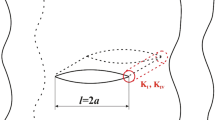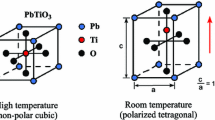Abstract
Electric fields effectuate the fracture behavior of ferroelectrics on different scales. On the atomic scale, forces in covalent bonds are influenced. On the mesoscopic scale, the ferroelectric domain wall motion shields the crack tip or leads to an additional loading. Based on classical approaches, on the macroscopic scale, the electric field has a major impact on the energy release rate and the electric displacement intensity factor; however, it scarcely influences the mechanical stress intensity factors. The situation is different if Maxwell stresses at crack faces, as a consequence of the jump of dielectric properties, are incorporated in the crack tip loading analysis. First, general considerations deal with the question how a fracture criterion has to be formulated, incorporating all three scales. On the macroscopic scale, the influence of an arbitrarily inclined electric field on the critical mechanical crack loading is investigated. The extended model, in particular, reveals the significance of electric fields parallel to the crack faces. A combined analytical–numerical approach is applied to solve the coupled two-domains problem of solid and crack dielectric, supporting the well-established capacitor approach even for inclined electric fields.
Similar content being viewed by others
References
Wang H., Singh R.N.: Crack propagation in piezoelectric ceramics: effects of applied electric fields. J. Appl. Phys. 81, 7471–7479 (1997)
Förderreuther A., Thurn G., Zimmermann A., Aldinger F.: R-curve effect, influence of electric field and process zone in BaTiO3 ceramics. J. Eur. Ceram. Soc. 22, 2023–2031 (2002)
Westram I., Ricoeur A., Emrich A., Rödel J., Kuna M.: Fatigue crack growth law for ferroelectrics under cyclic electrical and combined electromechanical loading. J. Eur. Ceram. Soc. 27, 2485–2494 (2007)
Pak Y.E.: Linear electro-elastic fracture mechanics of piezoelectric materials. Int. J. Fract. 54, 79–100 (1992)
Sosa H.: Plane problems in piezoelectric media with defects. Int. J. Solids Struct. 28, 491–505 (1991)
Park S.B., Sun C.T.: Effect of electric field on fracture of piezoelectric ceramics. Int. J. Fract. 70, 203–216 (1995)
Kuna M.: Finite element analyses of crack problems in piezoelectric structures. Comput. Mater. Sci. 13, 67–80 (1998)
Abendroth M., Groh U., Kuna M., Ricoeur A.: Finite element-computation of the electromechanical J-integral for 2-D and 3-D crack analysis. Int. J. Fract. 114, 359–378 (2002)
Hwang S.C., McMeeking R.M.: A finite element model of ferroelectric polycrystals. Ferroelectrics 211, 177–194 (1998)
Kamlah M., Liskowsky A.C., McMeeking R.M., Balke H.: Finite element simulation of a polycrystalline ferroelectric based on a multidomain single crystal switching model. Int. J. Solids Struct. 42, 2949–2964 (2005)
Li F., Fang D.: Simulations of domain switching in ferroelectrics by a three-dimensional finite element model. Mech. Mater. 36, 959–973 (2004)
Yang W., Zhu T.: Switch-toughening of ferroelectrics subjected to electric fields. J. Mech. Phys. Solids 46, 291–311 (1998)
Ricoeur A., Kuna M.: A micromechanical model for the fracture process zone in ferroelectrics. Comput. Mater. Sci. 27, 235–249 (2003)
Xu B.-X., Schrade D., Gross D., Müller R.: Phase field simulation of domain structures in cracked ferroelectrics. Int. J. Fract. 165, 163–173 (2010)
Li Q., Kuna M.: Evaluation of electromechanical fracture behavior by configurational forces in cracked ferroelectric polycrystals. Comput. Mater. Sci. 57, 91–101 (2012)
Janski L., Kuna M.: Adaptive finite element modeling of stationary and propagating cracks in piezoelectric structures. Arch. Appl. Mech. 63, 599–619 (2011)
Linder C., Rosato D., Miehe C.: New finite elements with embedded strong discontinuities for the modeling of failure in electromechanical coupled solids. Comput. Methods Appl. Mech. 200, 141–161 (2011)
Abdollahi A., Arias I.: Phase-field modelling of crack propagation in piezoelectric and ferroelectric materials with different electromechanical crack conditions. J. Mech. Phys. Solids 60, 21002126 (2012)
Wilson Z.A., Borden M.J., Landis C.M.: A phase-field model for fracture in piezoelectric ceramics. Int. J. Fract. 183, 135–153 (2013)
Kuna, M., Ricoeur, A.: Theoretical investigation of fracture behavior in ferroelectric ceramics. In: Bradt, R.C., et al. (eds.) Fracture Mechanics of Ceramics, vol. 13, pp. 63–82 (2002)
Gellmann R., Ricoeur A.: Some new aspects of boundary conditions at cracks in piezoelectrics. Arch. Appl. Mech. 82, 841–852 (2012)
Gellmann R., Ricoeur A.: Extended semi-analytical investigations of crack growth resistance behavior in ferroelectric materials. Acta Mech. 223, 2357–2368 (2012)
Barenblatt G.I.: The mathematical theory of equilibrium cracks in brittle fracture. Adv. Appl. Mech. 7, 55–129 (1962)
Hao T.H., Shen Z.Y.: A new electric boundary condition of electric fracture mechanics and its applications. Eng. Fract. Mech. 47, 793–802 (1994)
Kemmer G., Balke H.: Kraftwirkung auf die Flanken nichtleitender Risse in Piezoelektrika. ZAMM 79, 509–510 (1999)
Landis C.M.: Energetically consistent boundary conditions for electromechanical fracture. Int. J Solids Struct. 41, 6291–6315 (2004)
Ricoeur A., Kuna M.: Electrostatic tractions at dielectric interfaces and their implication for crack boundary conditions. Mech. Res. Commun. 36, 330–335 (2009)
Ricoeur A., Kuna M.: Electrostatic tractions at crack faces and their influence on the fracture mechanics of piezoelectrics. Int. J. Fract. 157, 3–12 (2009)
Brandt S., Dahmen H.D.: Elektrodynamik—Eine Einfhrung in Experiment und Theorie. Springer, Berlin (2004)
Wippler K., Ricoeur A., Kuna M.: Towards the computation of electrically permeable cracks in piezoelectrics. Eng. Fract. Mech. 71, 2567–2587 (2004)
Ricoeur A., Kuna M.: Influence of electric fields on the fracture of ferroelectric ceramics. J. Eur. Ceram. Soc. 23, 1313–1328 (2003)
Author information
Authors and Affiliations
Corresponding author
Rights and permissions
About this article
Cite this article
Ricoeur, A., Gellmann, R. & Wang, Z. Influence of inclined electric fields on the effective fracture toughness of piezoelectric ceramics. Acta Mech 226, 491–503 (2015). https://doi.org/10.1007/s00707-014-1190-5
Received:
Revised:
Published:
Issue Date:
DOI: https://doi.org/10.1007/s00707-014-1190-5




